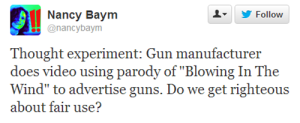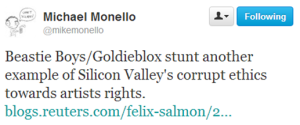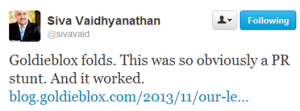As I am planning both a) a new chapter on the use of law and legalistic discourse as a point of contestation and language for communication between fans and industry and b) my next project about transformative musical reuse, I am increasingly convinced that what the law says doesn’t matter.
The Robin Thicke/Marvin Gaye case had been on my radar as a major flashpoint for the second project, because it operated at the intersection of the issues that interest me, between a) a strict copyright interpretation that said the song was in the clear and b) one informed by the history of white theft of black music and/or distaste for the gender and sexuality ideologies of “Blurred Lines” itself that wanted Thicke to get nailed for it.
And indeed when the verdict came down the other week, it showed some of the principles I’ve begun to formulate in theorizing these two projects: first, that what people use to decide whether something is legitimate transformative reuse (even juries) is not what the law says, and second, that the value system currently animating legal action is not what the law says either.
In the “Blurred Lines” case, first, the musical elements that the law says are subject to copyright and the factors people use to assess similarity or originality are poorly aligned. Kal Raustiala and Christopher Jon Sprigman argue at Slate that “the problem—and the reason the verdict in Blurred Lines is such a disaster—is that the jury appears to have been swayed by things that were not supposed to matter.” Legally speaking, Tim Wu notes in the New Yorker, “The question is not whether Pharrell borrowed from Gaye,” because clearly he did, “but whether Gaye owned the thing that was borrowed,” which Wu contends he did not. Chris Richards at the Washington Post concedes, “Yes, ‘Blurred Lines’ approximates the rhythm and timbre of ‘Got to Give It Up,’” but, he asks, “is that theft? Listen. Both songs have cowbell-ish percussion that plunkity-plunks at a similar tempo, but the patterns are different. Both songs have rich, teasing basslines, but the notes and rhythms of each are dissimilar.”
The consensus from these variously musically and legally trained commentators, then, is that, while there are definitely elements of the song that are similar, the particular similarities are not of a sort that are protected. This is particularly the case given that Gaye’s composition falls under the copyright rules that only protect the written notes, not any of these more intangible or non-notatable aspects of the “feel” that show up in the recorded version.
This leads Raustiala and Sprigman to conclude that “what the ‘Blurred Lines’ team copied is either not original or not relevant,” but I want to contest that point. By the letter of the law, no: rhythm, background noise, falsetto, funky bass, cowbell, or any of the other elements are not relevant, either because they’re not original to Gaye or not copyrightable or both. But they are clearly relevant to people who hear the songs, and that group includes jurors, which makes these aspects carry weight in legal cases whether they are supposed to or not. What the law says is not how people experience music, and neither is it how people hear similarity. Indeed, we could make an argument that, while none of the individual elements are unique to Gaye, the combination of them is what makes “Got to Give it Up,” and also what makes “Blurred Lines.” That’s not something the law can account for, but it is experientially true, and that has to be taken seriously even if for no other reason than that it impacts court decisions.
The second principle I have been formulating is that who did what to whom matters a great deal. As Richards notes,
An entire generation of American bluesmen died before sniffing the monthly private helicopter fuel budget of the rock-and-rollers who ran off with their sound. Others have settled out of court. And that’s one reason why a cheer went up on social media after Tuesday’s verdict was announced. This time, the young cads didn’t get away with it.
The history of white people stealing black music with impunity has everything to do with why this verdict “feels right” to people. Why, indeed, would the lawyers on the “Blurred Lines” side have gone to such lengths to position Pharrell Williams as the sole author, having Thicke disavow any role in composition and say that he was intoxicated when he claimed to have had a role, if not to try to ward off the specter of white people stealing black music?
Moreover, as Richards puts it, “Many people have a severe distaste for ‘Blurred Lines.’” Certainly, the song first came to my attention through the feminist critique of it as a rape culture anthem, in which Thicke sings that, although the “good girl” pretends not to be interested, he “knows she wants it.” (For a great side-by-side comparison of Blurred Lines with statements of actual rapists, see Sociological Images). Thus, Wu says, “many find the song’s lyrics and its music video morally objectionable, and it does not help that Mr. Thicke, with his aviators and swaggering demeanor,” is an unappealing figure. To add that the song is stolen, Wu notes, “completes the ‘jackass’ narrative nicely.”
And indeed, the “jackass narrative” and swagger, while legally irrelevant, turned out to be quite relevant. The Gaye estate’s lawyers certainly knew it. Wu notes that,
taking advantage of the fact that Gaye is considerably more popular and respected than Thicke, [they] made a dispute between two groups of wealthy people seem like a battle between good and evil. Rather than focussing on what Gaye’s estate actually owned, the trial became a referendum on Thicke’s character. As for that, the verdict was already clear.
This, of course, is not how the law is supposed to work, but it is often how the law does work, in practice. In a dispute between a person or category that one likes more and a person or category once likes less, interpretation favors the liked. (This, incidentally, is also why murder committed by police on black youth immediately becomes a referendum on character. Legally it doesn’t matter if it’s a “good” person or a “bad” person, because they never deserve to be a dead person, and clearly it is much more serious here than in intellectual property law, but nevertheless it is vital that we take seriously that such things influence whether such incidents are considered legitimate or illegitimate violence.) Therefore, when nasty Thicke was bested by beloved Gaye, “there was far more Schadenfreude than sorrow,” in Wu’s phrase.
However, this case also reveals a second way in which the law doesn’t matter. The point of copyright is to encourage creativity, under the logic that the nation benefits from innovation and innovation will be incentivized through a short-term, government-granted monopoly on otherwise uncontrollable ideas. Thus, as Raustiala and Sprigman argue, while basic fairness might dictate that Gaye’s estate be compensated for the inspiration he provided to “Blurred Lines,”
Basic fairness is not the goal of our copyright system. The reason we have copyright—the reason we protect songs, books, and other creative works for the life of the author plus 70 more years—is to adequately incentivize artists to produce new creative works. Copyright, at bottom, is about ensuring the flow and growth of culture. We encourage new creations by making sure creators know they stand to reap the benefits.
This verdict, according to legal and musical commentators alike, does not encourage people to make more music. To the contrary, they argue, it makes people afraid that what they previously may have regarded as benign influence is now actionable infringement. Raustiala and Sprigman worry that the verdict “may end up cutting off a vital wellspring of creativity in music—that of making great new songs that pay homage to older classics,” hurting not just artists but the very public copyright law is supposed to serve.
This demonstrates the ways in which copyright, at least since the second half of the twentieth century, is increasingly no longer oriented toward encouraging creativity. The original copyright of 14 years plus a 14-year extension encouraged people to create new things. A copyright term for the life of the author would potentially encourage people to create new things for the rest of their lives.
By contrast, extending copyright past the life of the author, as started with the Copyright Act of 1976 (life of the author plus 50 years) and continued with the Sonny Bono Copyright Term Extension Act of 1998 (life plus 70) ensures that your descendants reap the benefits of what they own as the result of being related to you. Setting up separate, longer standards for corporate authors (120 years after creation or 95 years after publication) it ensures corporations get paid for the intellectual property they own. We may think that this is reasonable because those goals are important, but they aren’t tied to encouraging creativity any longer. They may possibly have that effect still, but the basic orientation has changed.
In this new orientation toward ensuring people get paid for intellectual property they own, the casualty is the “flow and growth” of culture, because old creativity becomes permanently fenced off, never available to enrich the ground on which new creation happens. Raustiala and Sprigman contend that “the jury’s verdict casts a huge shadow over musical creativity and takes what should be familiar elements of a genre, available to all, and privatizes them,” and while I’m cautious about declaring things created by marginalized populations “available to all” (see my Fandom, Public, Commons), privatization is definitely the name of the game.
The orientation toward ensuring the owner gets paid is one toward safeguarding private property. It is not an orientation toward serving the public through creativity, and therefore it is not what US copyright law, in its inception, was for. This is, then, another way in which current legal wrangling is no longer tied to the law—in this case its origin.
In the end, then, while the “Blurred Lines” verdict may have been a miscarriage of justice, it is a very interesting and illuminating miscarriage of justice.



